
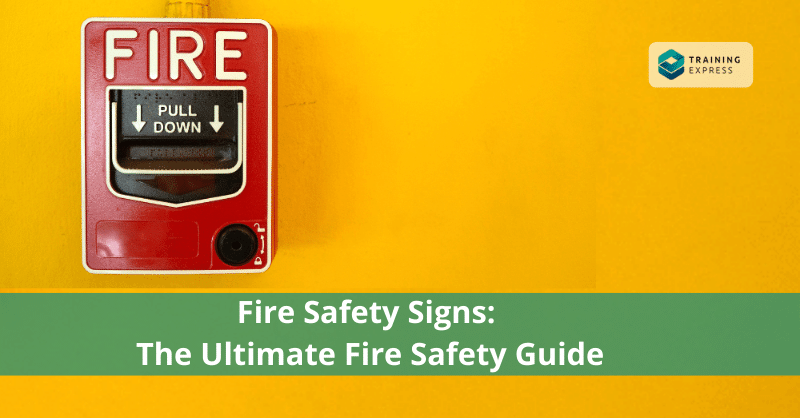
Close your eye and think about a scenario where you are desperately running to save yourself from the blazing flame, but all you find is a dead end. Scary right? No one wants to be in a position like this one. And this is where the fire safety signs come in. The fire safety signs direct people to safety when a fire hazard occurs.
Unfortunately, many of us don’t know what fire safety signs mean. Therefore, people can get confused about their purpose even with clear signage, often resulting in a life-threatening situation.
If you are also not well aware of the fire safety signs, don’t worry. This blog will provide you with an overall understanding of these signs. Along with learning the signs, you will also know how to follow them. Stick till the end!
Table of Contents
Why are Fire Safety Signs Important?
Fire safety signs save lives and prevent massive property damage.
These safety signs have two sections. One section helps avoid fire incidents, while the other instructs what to do during a fire. The signs for preventing fire allow people to understand the procedures required in order to avoid fire. Also, these signs mark and prohibit activities that can cause a fire. They play a vital part in reducing fire safety risks and ensuring a safe environment.
On the other hand, the second type of fire safety sign reduces the destruction caused by fire. These signs guide people to exit routes in times of danger. In addition, they indicate where to find fire equipment to extinguish the fire. Thus, these signs are very important in saving lives and putting out fires.
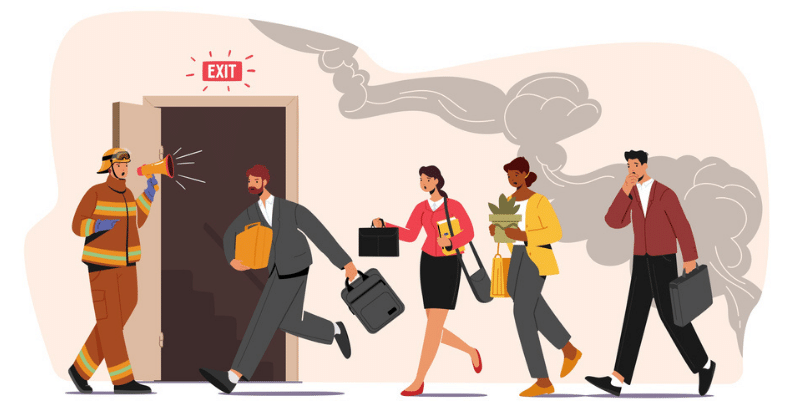
However, putting the signs is not enough. People living or working in the building should understand what each sign means. If they can’t understand the signs and can’t follow the instruction depicted in the signs, then every effort goes to waste. Hence, along with placing the signs, educating people about them is also equally critical.
What are the UK Regulations on
Fire Safety Signs?
Health and Safety (Safety Signs and Signals) Regulations 1996 provides a detailed description of the regulation regarding fire safety signage. Every workplace must follow the given rules and regulations on fire safety signage.
Here are a few key points mentioned in the regulation –
Is Fire Signage a Legal Requirement?
The UK government has created vital fire safety laws and regulations. Every business and organisation must comply with the Regulatory Reform (Fire Safety) Order 2005 (often referred to as RRO). They have to follow the instructions and procedures. Otherwise, they will be breaking the law.
According to the RRO, businesses must put up fire signage on their premises to minimise and eradicate fire hazards. Also, all employers are required to ensure a safe working place for their employees. And fire safety signs are pivotal for that. So, yes, fire safety signs are legally required for businesses or any premises.
What Does the Fire Safety Sign Colours Mean?
There are four colours used for fire safety signs – Green, Red, Yellow and Blue.
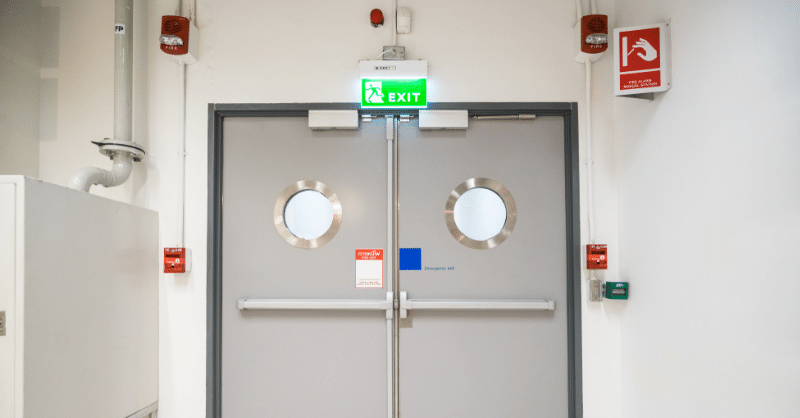
Green
If you’re wondering what colour is fire exit signs? It’s green. The green colour signs mean it’s safe to go through a certain route or do an action in case of a fire emergency.
Yellow
The yellow signs portray caution. They provide warning on what are the hazard risks in a certain area. For example, you can find them near flammable substances.
Red
Red colour signs mean a prohibition on specific actions, and it denotes danger. Along with that, the colour red is also used to indicate fire safety equipment. For instance, the fire extinguisher sign is red.
Blue
The blue safety signs instruct on actions that help in ensuring fire safety. For example, ‘Keep Clear’ or ‘Keep Door Shut’.
What are the Categories of Fire Safety Signs?
There are different types of fire safety signs that convey different meanings. The major categories of fire safety signs are as follows –
- Prohibition Sign
- Warning Sign
- Mandatory Sign
- Safe Condition Sign
- Fire Exit Sign
- Fire Equipment Sign
- Supplementary Information Sign
Keep reading to find out more about them.
Prohibition Signs
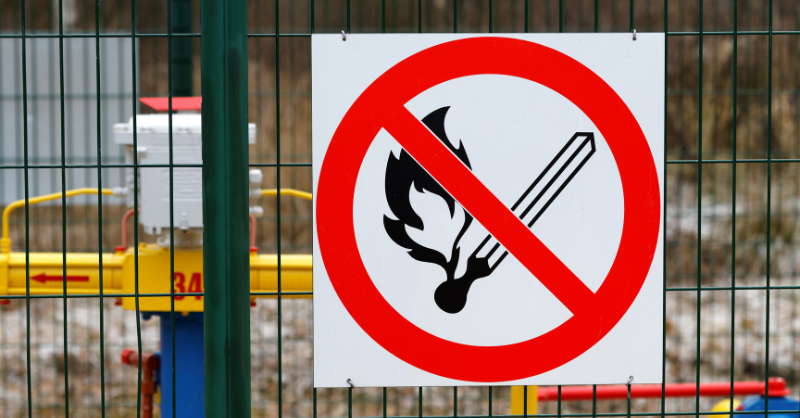
The prohibition sign is used in order to prevent the action that can increase fire risk. These signs bear ‘Do Not’ commands. For example, prohibition signs convey orders like ‘Do Not Smoke’, where smoking can be dangerous. The prohibition signs have a red band around with a 45-degree single bar descending from left to right. Inside the red band, the background is white, and the pictogram conveying the order is black.
These signs help in avoiding actions that can lead to fire risks. So, it is essential to place prohibition signs where needed, and everyone must follow them to prevent fire accidents.
Warning Signs
Warning signs are the signs that make people aware of the danger. These signs are used to inform people about flammable substances that are stored nearby.
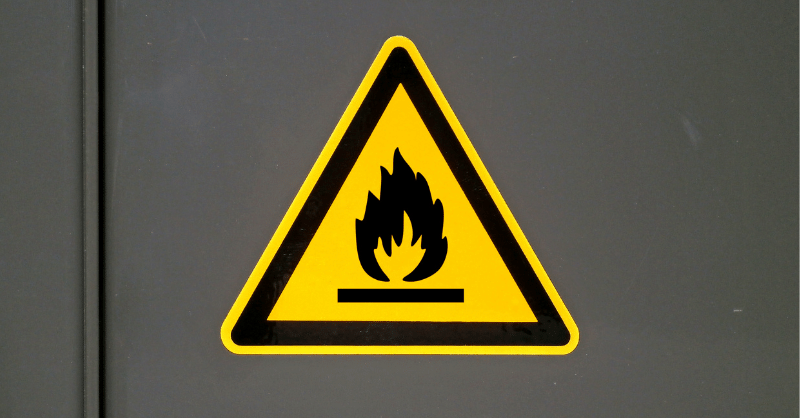
Warning signs are in the shape of equilateral triangles. There is a black band around the triangle, and the pictogram is in the middle. The pictogram is also black, and it represents the type of hazard. The pictogram is set on top of a yellow background.
Warning signs allow people to understand the risk factors. Moreover, It plays a significant role in creating a safe work environment. So, the warning signs should be placed properly and followed strictly at all costs.
Mandatory Signs
There are some important regulations for safeguarding the occupants of a building from fire risks. The signs that help people to comply with these regulations are mandatory signs. These signs are usually placed to indicate the actions that should be done. For instance, you can see the mandatory sign ‘Fire Door Keep Shut’ in front of a fire door that must be kept closed.
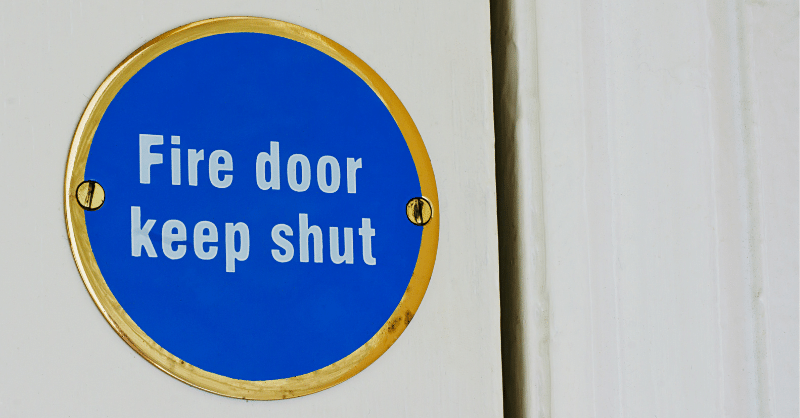
The mandatory signs are usually circular in shape with a blue background, and the command is in white writing on top of it.
Mandatory Signs show the action they can take in order to prevent a fire accident. Therefore, everyone must pay attention to these signs and follow them for their own safety.
Safe Condition Signs
The safe condition signs indicate fire escape routes, first aid equipment emergency exit, and fire assembly points. In addition, these signs guide and instruct the occupants of the building in case of fire emergencies. These signs are rectangles or squares. The background is green, and the symbols and writing on the signs are white.
Safe condition signs are integral in minimising casualties in fire accidents. Every building, commercial or non-commercial, must add the safe condition signs in places they are required.
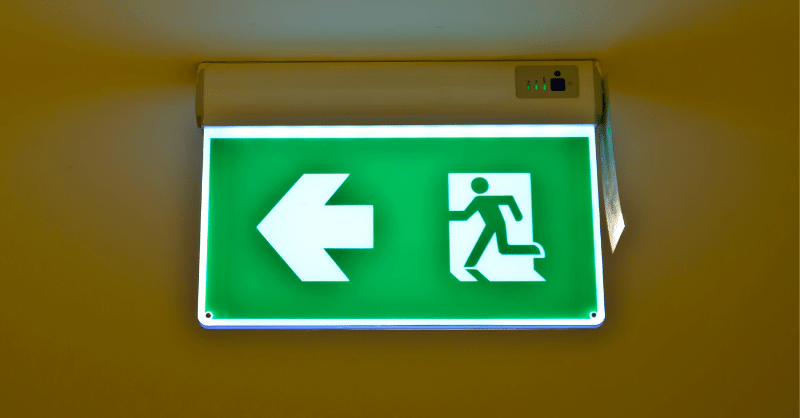
Fire Exit Sign
Fire exit signs are for directing the location of the fire exit doors. They help people to navigate and find the nearest fire exit. This sign is illustrated with white text and a symbol on a green background. The fire exit signs are rectangular in shape.
When fire accidents occur, people panic and rush everywhere to find an escape route. And if no proper guidance is provided for the exit, the whole situation can turn chaotic very quickly. So, there should be clear fire exit signs which will lead people to safety.
If you want to get a better understanding of the fire exit routes and their locations, the Fire Safety Training Course by Training Express is ideal for that.
Fire Equipment Signs
A fire equipment sign is for indicating where the fire equipment, like a fire extinguisher or water hose, is placed. These are rectangular or circular signs. Along with a red background, there is white writing and symbols on them.
In order to extinguish a fire, you have to know where essential fire equipment are. If the fire equipment can’t be found at the right time, it can cause massive damage to people and property. Thus, the fire equipment must be marked with proper signage.
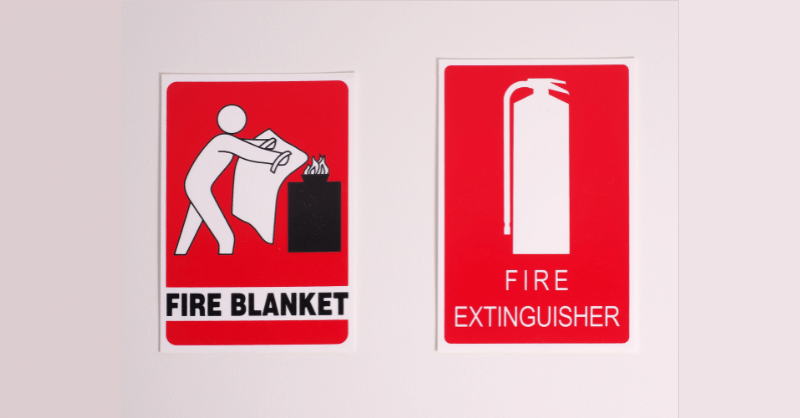
Learn the right way to use a fire extinguisher in this blog – How to Use a Fire Extinguisher? Advice for an Emergency Situation.
Supplementary Information Signs
Supplementary information signs are for providing additional directions. These signs are usually rectangular in shape, and the text or the pictogram is in white and placed in the centre of the sign. When the signs supplement safe conditioning signs, the background is green, red is for fire equipment signs, and yellow is for warning signs.
Supplementary signage provides additional information to people and helps them stay on course in case of a fire emergency. Hence, these signs are as much important as any other fire safety signs.
Additional Fire Safety Signs
Apart from the fundamental fire safety signs, there are some additional signs you can put up for extra protection. These signs are –
- Illumination Signs
- Acoustic Signals
- Spoken Communication
- Hand Signals
Illumination Signs
In case of a fire break out, power failure may occur. This can create difficulties for people in finding the signs. As a result, it will create panic and put people’s lives in jeopardy. In order to avoid situations like this, illumination signs can be used.
Transparent or translucent materials must be used for illumination signs so that the light is seen. The light must be inside the illumination signboard. In addition, there should not be any similar light source near the illumination signs.
Acoustic Signals
Acoustic signals are also very effective in case of emergencies. For acoustic signals to work properly, the sound level should be higher than the surrounding sounds, and it has to be familiar to the occupant of the premises. Moreover, for better results, devices with the capacity to emit sound in different frequencies can be used. The level of the frequency will convey the degree of danger.
Spoken Communication
Spoken signals delivered by human or artificial voices can also contribute to instructing people in danger. However, the spoken messages have to be clear, brief, and easily understandable to the listeners.
Hand Signals
Hand signals are also an effective way of directing people. These signals are on point and easy to understand. The signals are usually in coded form; thus, it is mandatory that everyone is aware of what the code means.
Fire Risk Assessment for Ensuring Fire Safety
Before placing the fire safety signs, there is one more crucial job, and that is fire risk assessment. After conducting the fire risk assessment, you can understand where the fire safety signs are required.
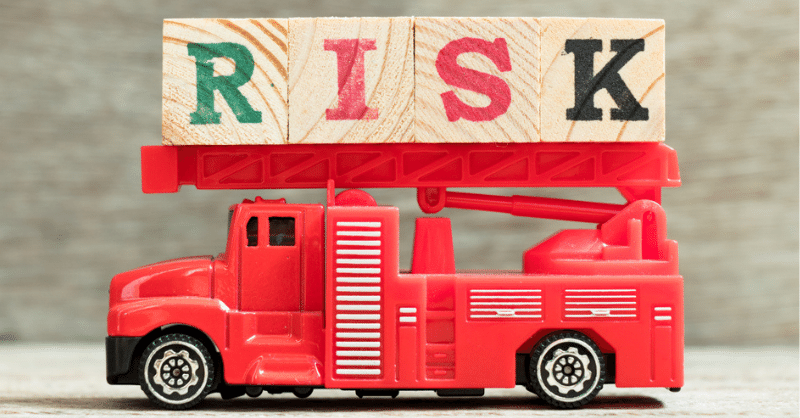
So, what are the steps in a fire risk assessment? There are a few steps you need to follow to conduct a fire risk assessment. These are:
- Step-1 Identify the Fire Hazards
- Step-2 Identify the People at Risk
- Step-3 Evaluate the Premises
- Step-4 Record the Findings
- Step-5 Keep a Tab on Fire Risk Assessment
These steps are described below.
Step-1 Identify the Fire Hazards
In the first step, you need to identify the fire hazards within the premises. Look for sources of ignition like heaters, open flames, etc. Then try to figure out if there is any source of fuel that can contribute to the fire. For instance, wood, paper, waste, petrol, kerosene, etc., are defined as the fuel for the fire. After that, identify the oxygen source, like air conditions or ducts.
Step-2 Identify the People at Risk
The second step is to identify the people at risk. People who are at fire risk may include –
- People who stay in the area
- Anyone who doesn’t know the layout of the premises
- People exposed to a particular fire risk
- People with disabilities
- Anyone who is near a fire threat or works in an isolated area
- Parents with babies, children, and elderly people
- Temporary staff or contractors
Step-3 Evaluate the Premises
In this step, your job is to evaluate the premises. After a thorough inspection, determine the risks for fire occurrence. Then your duty is to determine the consequences of a fire break out. After that, you have to understand the level of the risk. Once you specify the risk level, take action accordingly to mitigate the risks.
Step-4 Record the Findings
In step four, you have to record the findings you have gathered from the previous steps. The hazards and the people you have identified who are prone to risk and the information you have collected from the evaluation process, you have to record all of that.
After that, according to the information, you must create an emergency plan. It is recommended to take help from professionals like the fire marshal in developing the plan. In addition, you should give fire safety training to the occupant of the building or the premises.
Step-5 Keep a Tab on Fire Risk Assessment
The final step is to keep a tab on your fire risk assessment. It is not ideal to cling to the same risk assessment for years. Instead, you must re-examine your fire risk assessment on a regular basis. Also, if you find any issues or changes, immediately update your emergency plan. This will help you stay safe and protect you from dangers.
Final Words
Fire hazards are like deadly monsters that consume everything on their paths. The only way you can prevent fire hazards is by following the fire safety legislation and placing the fire safety signs in the right places.
However, if you want to go the extra mile in ensuring the safety of your loved ones and your property, the Fire Safety Training Course is what you need. This course will provide detailed training on fire safety and help you take the necessary steps. Join now!
- Available Courses
- Career Bundles73
- Animal care5
- Law8
- Quality Licence Scheme Endorsed111
- Teaching13
- Teaching & Academics Primary26
- Accounting & Finance Primary30
- Training3
- Design15
- IT & Software138
- Healthcare127
- Marketing31
- Health and Safety406
- Construction48
- Electronics25
- Hospitality22
- Health and Social Care220
- Child Psychology37
- Management378
- Business Skills268
- First Aid70
- Employability264
- Safeguarding75
- Food Hygiene103
- Personal Development1352
 Food Hygiene
Food Hygiene Health & Safety
Health & Safety Safeguarding
Safeguarding First Aid
First Aid Business Skills
Business Skills Personal Development
Personal Development












